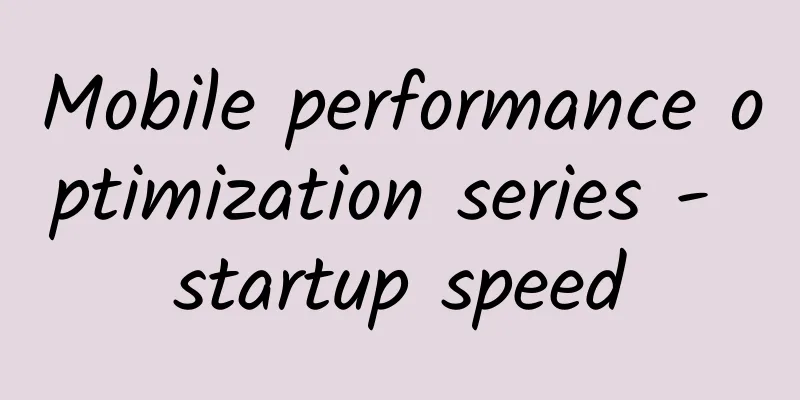Mobile performance optimization series - startup speed

|
Mobile performance has a crucial impact on user experience and retention. As a developer, have you ever been complained about, "Why is this app so big?", "Why does it keep wandering around the app cover and can't click into it?", "It's a bit slow to enter the details?", "I'm using your app on 4G, but my data is a bit insufficient", etc. These problems directly reflect that for an app with a good experience, it is not enough to have only sound functions. The following are some points I have summarized on performance optimization: Startup speed optimization Fluency optimization Resource optimization Memory optimization Let’s talk about startup speed today. Application startup process Cold Start The entire process from clicking the application icon to the UI interface being fully displayed and user-operable. Features: Most time-consuming, measurement standard Start the process: Click Event -> IPC -> Process.start -> ActivityThread -> bindApplication -> LifeCycle -> ViewRootImpl Hot Start Because it will be started from an existing application process, the Application will not be created and initialized again, only the Activity will be recreated and initialized. Features: Less time consuming Startup process: LifeCycle -> ViewRootImpl Therefore, the standard for judging the startup speed of an application is the cold start speed, that is, the speed of restarting after killing the application. This item is mainly compared with your competitors. You should not perform any time-consuming operations in the lifecycle callbacks of Application and Activity. The specific indicator is that the total time you spend in callbacks such as onCreate, onResume, onStart, etc. should not exceed 400ms. Otherwise, the user will feel a noticeable lag after clicking your application icon on the desktop. Cold start analysis and optimization direction Related tasks involved in cold start Before cold start First, the App will be launched Then, load a blank Window Finally, create the process It should be noted that these are all system behaviors, and generally we cannot intervene directly. Subsequent tasks First, create an Application Start the main thread Create MainActivity Loading Layout Arrange the screen First frame drawing Usually, after the first frame of the interface is drawn, we can consider that the startup is complete. The following is a flowchart of the startup process from the official documentation, showing how the system process and the application process hand over work. In fact, it is a brief summary of the startup process. Optimization direction Our optimization direction is the life cycle of Application and Activity. We cannot intervene in the system tasks during startup. What we can intervene are the performance problems that may occur during the process of creating applications and creating Activities. This process is specifically: Application's attachBaseContext Application's onCreate Activity's onCreate activity's onStart Activity onResume The first frame drawing starts after the activity's onResume method is completed. Therefore, we should try our best to avoid time-consuming operations in these methods. In addition, usually, the data of an application's home page needs to be requested from the network, so when users start the application, they hope to quickly enter the home page and see the home page data, which is also a basis for us to calculate the start-up end time. Application of U-APM in startup optimization I used to use Umeng statistics to analyze App DAU, tracking points and other data, and then I discovered U-APM launched by Umeng, so I quickly tried it out. U-APM is an App stability monitoring, performance monitoring and cloud real machine testing platform launched by Umeng+. Through lightweight integrated access, it can have real-time, reliable and comprehensive application crash, ANR, custom exception capture capabilities, as well as performance capabilities such as freeze and startup analysis. It supports multi-scenario, multi-channel intelligent alarm monitoring, helping developers to efficiently restore the access path and business site of abnormal and stuck users, and shorten troubleshooting time. Let's take a look at what U-APM does in terms of startup analysis. U-APM supports startup trend analysis, slow start analysis, and startup crash analysis. Start trend analysis The startup trend more intuitively displays the average, percentile, interval distribution and other data of the application startup time, as well as the performance decomposition data of the startup phase. It can also analyze the distribution of startup time after multiple version iterations. Slow start analysis Slow start analysis helps developers trace the source of the problem. This feature displays the percentage of slow start situations and a list of slow start devices. You can customize the classification of slow start in the startup settings. By default, a first startup or cold start that takes more than 3 seconds is considered a slow start, and a hot start that takes more than 1 second is considered a slow start. The slow start analysis during the cold start phase intuitively shows the slow start ratio and the average slow start time. Slow start distribution intuitively shows the devices, systems, operators, versions, channels, and regions where slow start is distributed. Start Crash Analysis Summarizes crash information that occurs during the startup phase, and supports the classification of crashes during first startup, cold startup, and hot startup. The default startup time limit is 8 seconds, and crashes that exceed the time limit are not classified as startup crashes. Start Crash Analysis Summarizes crash information that occurs during the startup phase, and supports the classification of crashes during first startup, cold startup, and hot startup. The default startup time limit is 8 seconds, and crashes that exceed the time limit are not classified as startup crashes. This is of great help in reducing the application startup time. The official demo has been provided. Summarize Mobile performance optimization is closely linked, and startup time optimization is also a relatively important link. The emergence of U-APM is undoubtedly a benefit for developers, helping developers to discover and solve problems early. As for other functions of U-APM, you can log in to the official website to experience it. |
<<: 23 pictures to explain routing protocol: the core technology of computer network
>>: Why 5G and IoT security is more important than ever
Recommend
Listen to what the broadband master said: How often should the router be turned off? Otherwise, the WiFi will become slow
Tomorrow is the end of the holiday. If you stay a...
After the fourth retail revolution, three experts from WOT tell you what real smart retail is!
[51CTO.com original article] On June 21, the WOT2...
iWebFusion: US servers start at $49/month, 10Gbps bandwidth servers start at $149/month, Los Angeles 4G memory VPS monthly payment starts at $9.38
iWebFusion is a foreign hosting company founded i...
5G private network is a big watermelon (Part 3): Difficulty in synthesis
To some extent, 5G private network does not allow...
An article to show you how to use Nginx as a proxy for WebSocket
Hello everyone, I am Xiao Jiang. The previous art...
Do you know how much power 5G actually consumes?
5G is one of the hottest topics at the moment, an...
[11.11] Megalayer: 50% off on regular VPS, Hong Kong/Philippines/US VPS starting at 159 yuan per year
Megalayer also launched a promotion for the Doubl...
Huawei releases smart security distribution business strategy and four new AI products
[Shenzhen, China, March 20, 2020] Today, Huawei&#...
Interviewer: What are the ways of communication between components in React?
[[409233]] This article is reprinted from the WeC...
My girlfriend suddenly asked me what DNS is...
[[357457]] This article is reprinted from the WeC...
Telecommunications industry becomes the largest AI market and will reach an important turning point in 2021
Tractica/Ovum, a world-renowned market research c...
How to future-proof your home network with FTTR
The demand for high-speed internet and seamless c...
If you understand long-distance relationships, you will understand how to configure switches.
We have explained the configuration of switches m...
Alibaba Cloud Golden Autumn Cloud Season, Cloud Server Flash Sale 2C2G5M Annual Payment Starting from 60 Yuan
Alibaba Cloud (aliyun) launched another Golden Au...
Sharktech: Denver high-end 1Gbps unlimited traffic server $129/month, Los Angeles 1Gbps unlimited traffic starting at $59/month
Sharktech has launched a new high-end server prom...









